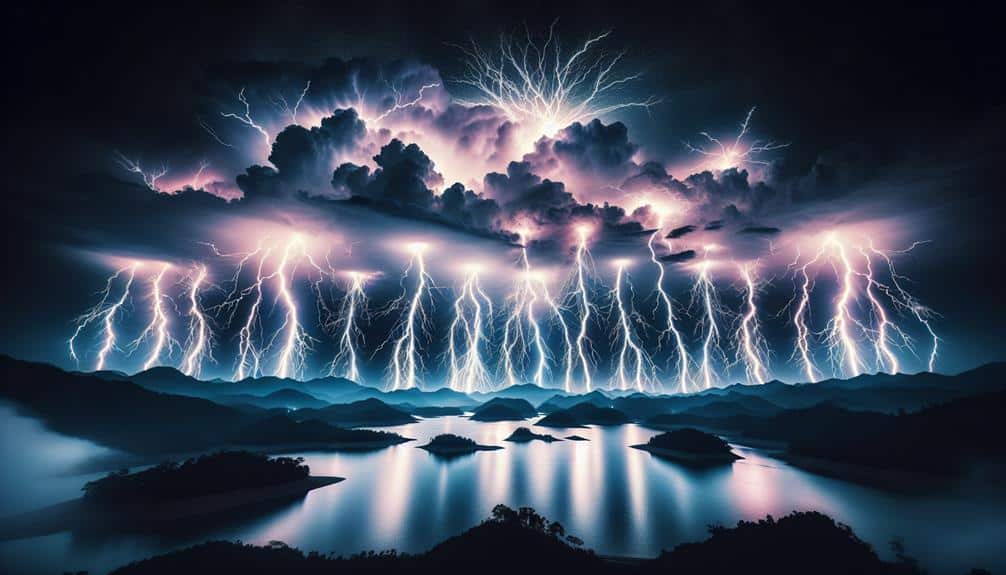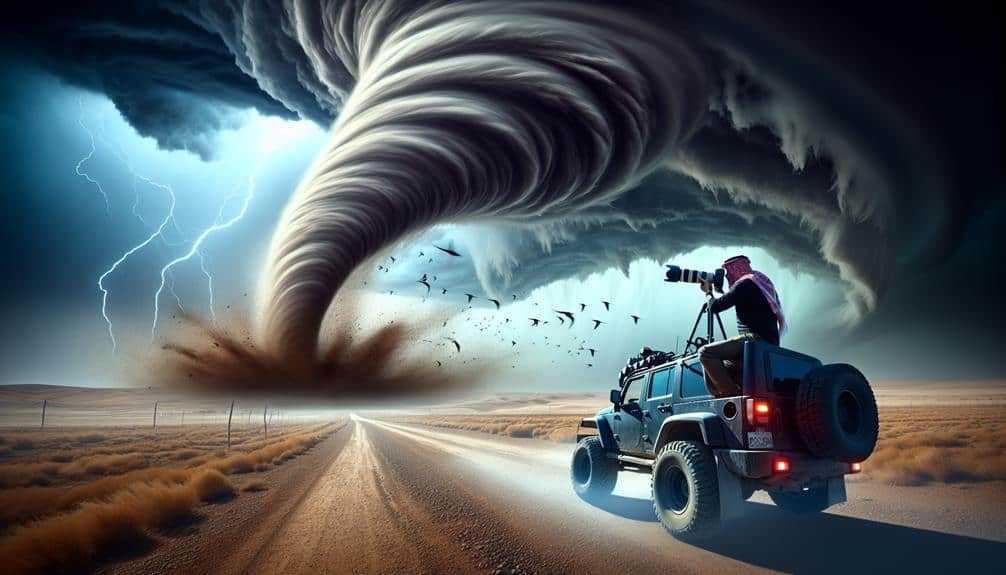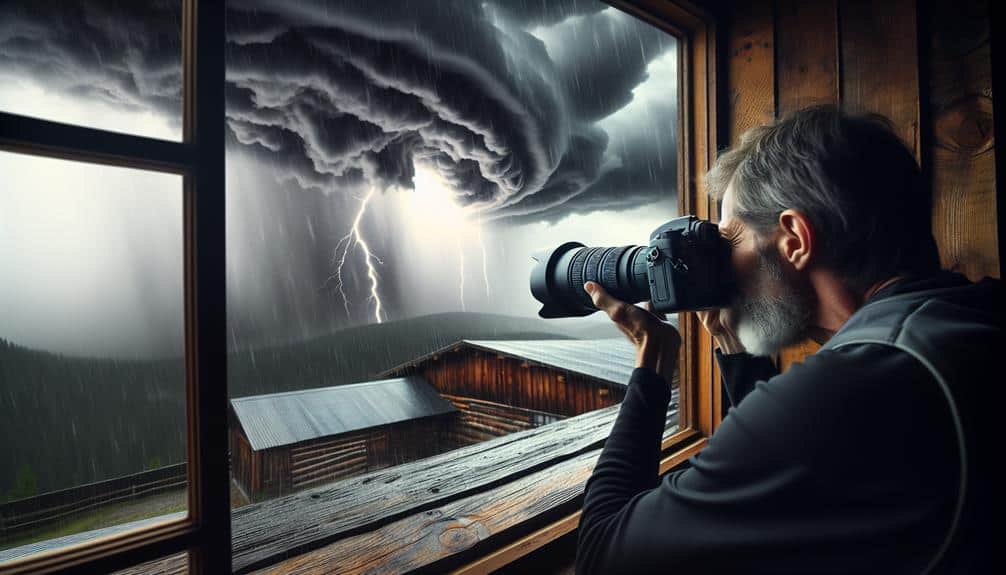Surviving and excelling in tornado photography demands a mix of expert equipment, precise timing, and steadfast safety protocols. We require sturdy DSLR cameras, weather-proof bags, and windproof attire to endure challenging conditions. Monitoring live weather updates with Doppler radar guarantees we capture key moments, while pinpointing evacuation routes and emergency shelters ensures our safety. Leveraging golden hour lighting and the rule of thirds improves our compositions. While safeguarding our shots, prioritizing shelter and survival is crucial. For those keen to excel in the art of tornado photography and enhance their skills, there's a wealth of knowledge to explore.
Key Points
- Prioritize safety: Always identify emergency shelters and evacuation routes before setting up for tornado photography.
- Use advanced weather tools: Leverage radar technology and satellite imagery to track and predict tornado paths accurately.
- Equip properly: Carry a weather-sealed camera, protective gear, and backup equipment to handle unpredictable conditions.
- Engage online: Showcase your work on platforms like Instagram and 500px with high-quality captions and relevant hashtags.
Understanding Tornadoes
Understanding tornadoes requires a thorough exploration into the intricate atmospheric conditions that give rise to these awe-inspiring and destructive phenomena. Tornado formation begins with a combination of warm, moist air near the ground and cooler, dry air above. When these air masses collide, they create instability. Add wind shear—changes in wind speed and direction with altitude—and we get the rotation necessary for a tornado to form.
As storm chasers, we're drawn to this volatile interplay of elements, but we must prioritize tornado safety. It's crucial to debunk tornado myths that can lead to dangerous decisions. For instance, some believe that the southwest corner of a basement is the safest spot during a tornado, but it's actually important to stay away from windows and cover yourself with sturdy furniture or a mattress.
While the thrill of capturing a tornado on camera is undeniable, understanding these atmospheric dynamics and debunking myths helps us stay safe. We're not just chasing storms; we're deciphering nature's most violent spectacles.
Let's embrace the freedom of knowledge and respect the raw power of tornadoes, ensuring we're well-prepared and informed as we venture into the storm.
Essential Gear Checklist
Equipped with the right gear, we can safely and effectively capture the raw power of tornadoes on camera. Our primary tool is a high-quality DSLR or mirrorless camera, capable of handling rapid changes in light and movement. Important camera settings include a high shutter speed to freeze the motion and a wide aperture to capture as much light as possible, even in the darker stormy conditions.
We can't overlook the significance of protective gear. A sturdy, weather-sealed camera bag ensures our equipment stays dry and safe from debris. Wearing durable, wind-resistant clothing and eye protection shields us from the elements, allowing us to focus on our shots.
An emergency plan is essential. Keeping a fully charged mobile phone and a GPS device ensures we stay connected and can navigate to safety if needed. Backup equipment, such as extra batteries, memory cards, and a secondary camera, guarantees that technical failures don't halt our mission.
Each of these items isn't just a luxury but a necessity. They provide the freedom to chase storms confidently, knowing we're prepared for any unpredictable turns weather might throw our way.
Safety Precautions
While having the right gear is critical, our primary concern must always be our safety when out in the field.
Tornadoes are unpredictable and can change direction in seconds, making it crucial to identify emergency shelters and establish clear evacuation routes before we even set up our tripods. Knowing the nearest sturdy buildings or underground shelters can be a lifesaver when the storm's fury intensifies.
We should also create a strong communication plan. This involves informing someone reliable about our exact location and expected return time. Keeping emergency contacts on speed dial ensures we can quickly reach out for help if the situation goes south.
Our vehicles should be prepped as mobile command centers, stocked with first aid kits, water, non-perishable food, and blankets. Monitoring real-time weather updates through reliable sources keeps us one step ahead of the storm.
Always remember, in the chaos of a tornado, our instincts might scream for the best shot, but survival is paramount. Observing the storm's behavior, having a clear escape route, and maintaining constant communication aren't just best practices—they're crucial.
Our freedom to chase these awe-inspiring phenomena hinges on our commitment to these safety precautions.
Capturing the Perfect Shot
Capturing the perfect shot of a tornado demands precise timing, the right equipment, and an eye for dramatic composition. Our mission is to freeze that moment in time, transforming nature's raw power into a visual masterpiece. Here's how we can achieve that:
1. Lighting Techniques:
Understanding the interplay between light and shadow is vital. We should aim for that golden hour when the sun's angle enhances the tornado's structure. Adjusting our camera settings to balance exposure guarantees that the tornado's details aren't lost in overexposure or underexposure.
2. Composition Tips:
Framing the tornado with surrounding elements like landscape or clouds adds depth. The rule of thirds can guide us in creating a balanced and compelling image. We should always consider the horizon line and leading lines to draw the viewer's eye into the storm's core.
3. Equipment Maintenance:
Ensuring our gear is in top condition is essential. Regular checks on lenses, sensors, and tripods can prevent unexpected failures. Keeping our equipment clean and dry amidst the chaotic environment is paramount.
4. Camera Settings:
Using a fast shutter speed captures the tornado's swift movement without blur. A low ISO setting minimizes noise, while manual focus ensures sharpness. Continuous shooting mode can help us seize multiple frames of the action.
Weather Forecasting Tools
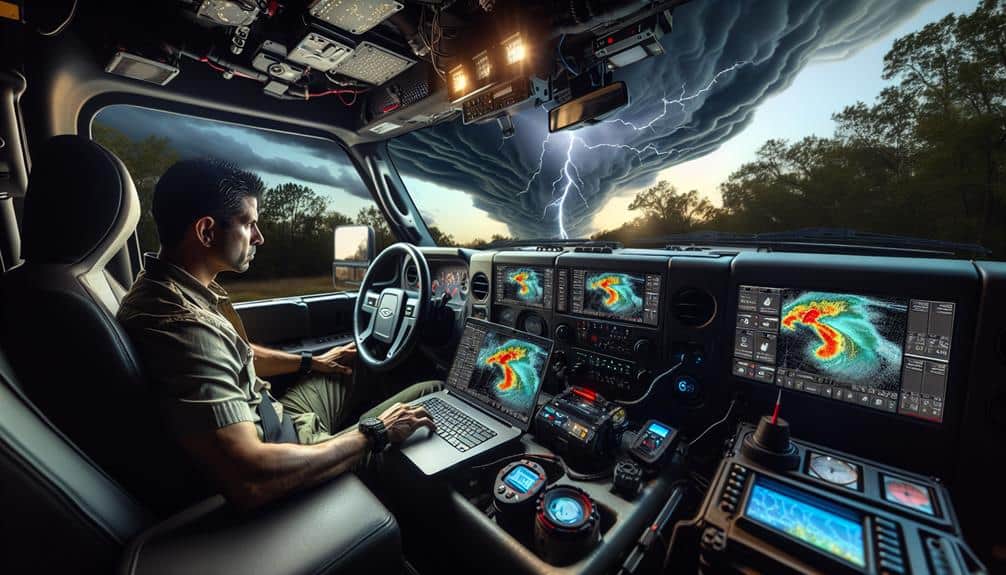
To anticipate and capture the perfect tornado shot, we must rely on advanced weather forecasting tools to track storm developments accurately. Our primary allies in storm tracking are radar technology and satellite imagery. These tools provide real-time data on atmospheric conditions, enabling us to position ourselves strategically.
Radar technology, particularly Doppler radar, is indispensable. It measures the velocity and direction of storm systems, allowing us to detect rotation within a thunderstorm—a precursor to tornado formation. By analyzing radar signatures, we can identify supercells and track their paths with precision. This real-time information is essential, giving us the edge to anticipate where the tornado might touch down.
Satellite imagery complements radar data by offering a broader perspective of atmospheric conditions. High-resolution images from geostationary satellites reveal cloud formation, temperature variations, and moisture levels in the atmosphere. By interpreting this data, we can predict storm intensification and movement patterns.
Harnessing these sophisticated tools allows us to embrace the unpredictability of nature while maintaining our freedom to chase and capture its most dramatic moments. With precise storm tracking and detailed atmospheric insights, we position ourselves not just to survive, but to thrive in the exhilarating pursuit of tornado photography.
Post-Processing Techniques
Post-processing transforms raw tornado images into striking visual narratives, enhancing details and emphasizing the drama inherent in these powerful natural phenomena. As we explore post-processing, a few vital techniques stand out.
- Color Correction: Ensuring accurate and vibrant colors is essential. We adjust the white balance to reflect the true hues of the storm, making the swirling clouds and lightning bolts pop. Subtle tweaks in saturation and contrast can make a world of difference.
- Sharpening: Tornadoes are dynamic and fierce, and sharpening brings out the minute details that highlight their intensity. We carefully increase the clarity to reveal the intricate textures of the storm, from the debris in the air to the turbulent cloud formations.
- Noise Reduction: High-ISO settings often introduce noise, especially in low-light conditions. We use noise reduction techniques to smooth out graininess without losing crucial details, ensuring a clean, polished image.
- Cropping: Composition is key in storytelling. We crop to focus on the most compelling parts of the scene, eliminating distractions and honing in on the raw power of the tornado.
Sharing Your Work
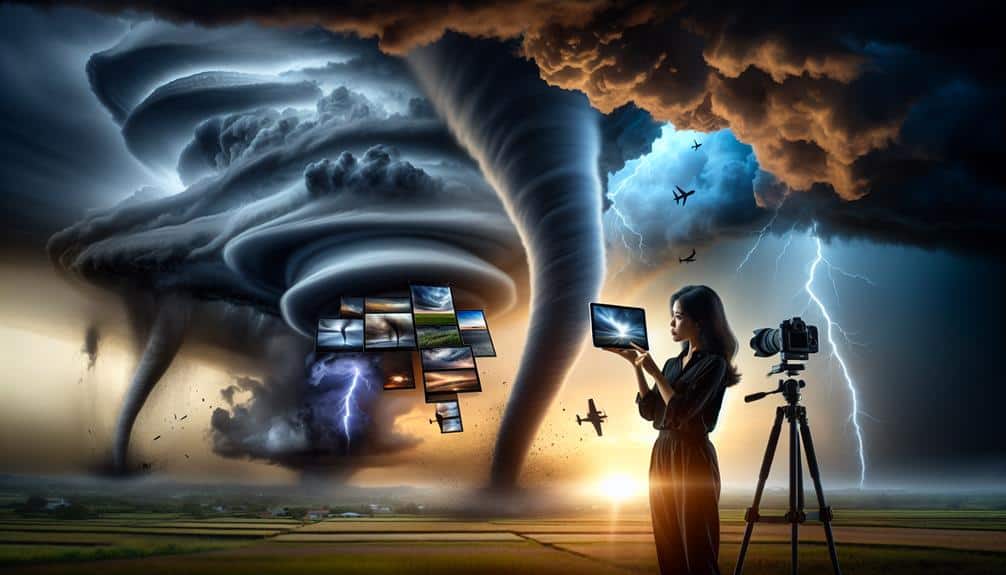
Having perfected our images through meticulous post-processing, we can now focus on effectively sharing our awe-inspiring tornado photography with a wider audience. Online platforms like Instagram, Flickr, and 500px offer us the perfect stage to showcase our work. These platforms not only provide visibility but also allow us to connect with a community of like-minded enthusiasts and potential clients.
To make our photos stand out, let's use high-quality, eye-catching captions and relevant hashtags. Engaging with our audience through comments and stories can build a loyal following.
While sharing, it's crucial to make sure our work is protected. Adding watermarks to our images is a simple yet effective method for copyright protection.
Additionally, we should consider licensing our images through platforms like Shutterstock or Getty Images. These services offer another layer of copyright protection and can provide a source of income.
Frequently Asked Questions
What Are the Best Locations for Tornado Photography?
We should seek ideal locations like the Great Plains, where tornadoes are frequent. Prioritize safety measures: maintain distance, use sturdy structures for shelter, and always have an escape route. This secures our freedom to capture nature's fury safely.
How Can I Join a Storm Chasing Group?
Joining a storm chasing group is like embarking on a thrilling adventure. First, research groups that prioritize safety protocols. Understand their group dynamics to guarantee you're a good fit. Engage with their community and show your enthusiasm!
What Insurance Should I Have for Tornado Photography Gear?
Let's make sure we have thorough insurance coverage for our gear protection. We should look into equipment replacement policies and explore different coverage options to safeguard our investments, making sure we're ready for any tornado photography adventure.
How Do I Stay Updated With Tornado Photography Communities?
Did you know 70% of tornado photographers connect through online forums and workshops? We should stay updated by engaging in social media and networking. It's essential for sharing tips, experiences, and expanding our knowledge and community.
Can I Monetize My Tornado Photographs?
We can definitely monetize our tornado photographs by selling prints, stock images, and licensing images for various uses. Additionally, creating and selling merchandise like calendars and posters can generate significant income while sharing our vivid, awe-inspiring work.
